The Blue Moon Diamond is a truly remarkable gemstone that has captivated the world with its exceptional beauty, rarity, and unique characteristics. This exquisite diamond holds great significance in the realm of fine jewelry and gemology, making it a highly sought-after and prized gem.
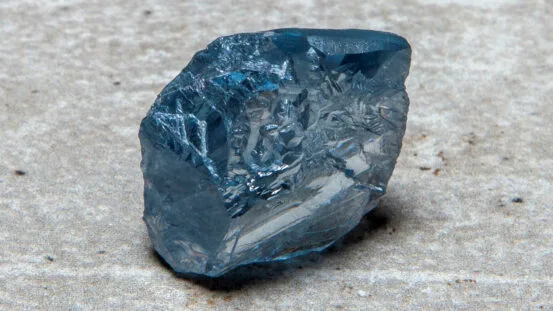

What sets the Blue Moon Diamond apart is its extraordinary blue color, which is both vivid and enchanting. Blue diamonds are among the rarest of all colored diamonds, and the Blue Moon Diamond’s vivid hue places it in an elite category of truly exceptional gems. The mesmerizing blue color is often attributed to trace amounts of boron present within the diamond’s carbon structure during its formation process.
Equally remarkable is the diamond’s high clarity, which adds to its allure. Clarity refers to the presence or absence of internal flaws (inclusions) and surface imperfections (blemishes) within a diamond. The Blue Moon Diamond boasts an impeccable clarity grade, meaning it is nearly devoid of any visible inclusions or blemishes when viewed under magnification. This remarkable clarity further enhances the diamond’s visual appeal, allowing its exquisite blue color to shine through with unparalleled brilliance.
Due to its extraordinary combination of rarity, intense blue color, and exceptional clarity, the Blue Moon Diamond has become a symbol of luxury, prestige, and elegance. Its scarcity and unique features have contributed to its reputation as one of the world’s most valuable and covetable gemstones, making it a true masterpiece of nature and a treasured addition to the world of haute joaillerie.
Diamond Formation and Properties
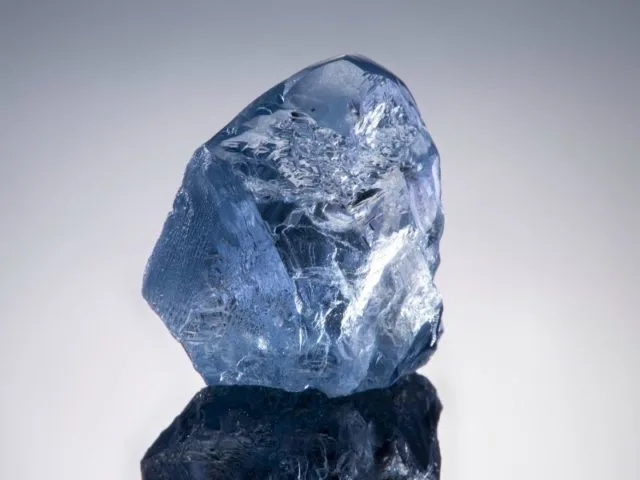
Diamonds are formed deep within the Earth’s mantle through a complex and fascinating geological process that takes millions of years. The journey begins with carbon atoms, which are subjected to high temperatures and pressures, transforming them into the dazzling gems we know as diamonds.
Geological Processes in Diamond Formation:
- Carbon-Rich Source: The primary source of carbon for diamond formation is organic material that is buried and subjected to immense pressure over time. This carbon can come from various sources, including plant and animal remains, which are compressed and carbonized deep within the Earth.
- Subduction and Plate Tectonics: Subduction occurs when one tectonic plate is forced beneath another into the Earth’s mantle. As the subducting plate descends into the mantle, it carries with it carbon-rich materials. The intense pressure and heat in the mantle cause these carbon materials to crystallize into diamonds.
- High Pressure and Temperature: Diamonds form under extremely high pressure and temperature conditions, typically at depths of around 100 to 150 miles (150-250 kilometers) below the Earth’s surface. The pressure can reach several gigapascals, and the temperature can exceed 2,000 degrees Celsius (3,600 degrees Fahrenheit).
- Kimberlite and Lamproite Eruptions: The diamonds that form deep within the Earth are brought closer to the surface through volcanic eruptions. Kimberlite and lamproite are types of volcanic rocks that carry diamonds from the mantle to the surface in narrow, pipe-like structures called kimberlite pipes or volcanic vents.
Formation of Colored Diamonds: Colored diamonds, including the Blue Moon Diamond, gain their distinct hues from trace elements present during their formation. The specific conditions necessary for the formation of colored diamonds can vary depending on the element involved. In the case of blue diamonds like the Blue Moon Diamond, the blue coloration is attributed to the presence of boron.
Boron, which is a chemical element, can substitute for carbon atoms within the diamond’s crystal lattice. This substitution introduces unique color centers that absorb certain wavelengths of light, resulting in the blue color. The intensity and shade of blue can vary based on the concentration and arrangement of boron atoms.
It’s important to note that the formation of colored diamonds requires precise and relatively rare conditions. Even minor variations in the composition and conditions during diamond growth can lead to different colors or no color at all. This rarity and the intricate geological processes involved contribute to the exceptional beauty and desirability of colored diamonds, making them some of the most prized and valuable gemstones in the world.
Origin of Color in Diamonds
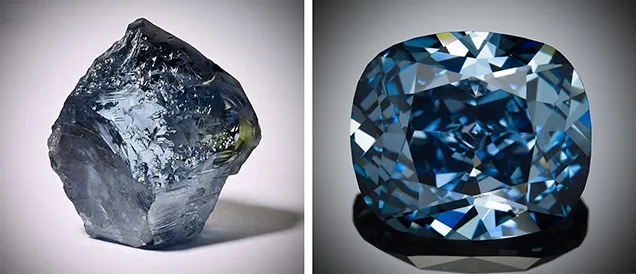
The captivating colors exhibited by diamonds are often the result of impurities or structural defects within the diamond’s crystal lattice. These imperfections interact with light, causing it to be absorbed or scattered in ways that create the stunning array of colors we see in colored diamonds. The coloration of a diamond can be influenced by a variety of factors, including the type and concentration of impurities present.
In the case of blue diamonds, like the Blue Moon Diamond, the presence of boron is a key factor in creating the distinct blue color. Boron is a trace element that can replace carbon atoms within the diamond’s lattice structure. This substitution introduces color centers, also known as “trapped electrons,” which are responsible for absorbing specific wavelengths of light in the visible spectrum. The absorbed light energy promotes electrons to higher energy states within the lattice, resulting in the diamond’s characteristic blue color when certain wavelengths are absorbed and the complementary blue wavelengths are transmitted.
The exact shade of blue in a boron-infused diamond can vary based on factors such as the concentration of boron, its arrangement within the lattice, and the presence of other impurities. Blue diamonds can range from pale or light blue to deep and vivid hues, with intensity often determining their value and desirability.
Aside from boron, other trace elements can also influence diamond color:
- Nitrogen: Nitrogen is one of the most common impurities found in diamonds and is responsible for creating a range of colors, including yellow and brown. The presence of nitrogen atoms can absorb blue light, allowing yellow and brown wavelengths to dominate, resulting in the diamond’s perceived color.
- Hydrogen: Hydrogen impurities can lead to the creation of violet or purple hues in diamonds. These colors are often seen in conjunction with other impurities, such as nitrogen.
- Vacancies and Dislocations: Structural defects in the diamond lattice, such as vacancies (missing atoms) or dislocations (imperfect arrangements of atoms), can also influence color. These defects can alter the way light interacts with the diamond, leading to various colors.
- Radiation and Pressure: External factors like radiation and high pressure can also introduce color changes in diamonds by altering the arrangement of atoms and lattice structure.
It’s important to note that the interplay of these factors is incredibly intricate and can lead to a wide spectrum of colors, each with its own unique beauty and rarity. The precise conditions and impurities that contribute to a diamond’s color are a testament to the complex geological and chemical processes that occur deep within the Earth, resulting in the breathtaking and diverse world of colored diamonds.
Geological Source of the Blue Moon Diamond
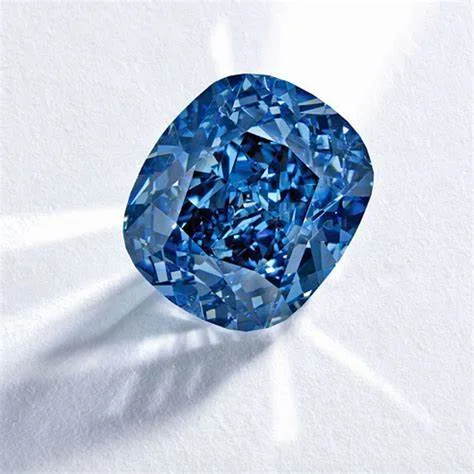
The geological source of the Blue Moon Diamond, like all natural diamonds, can be traced back to specific diamond-producing regions or geological formations. While it’s challenging to pinpoint the exact origin of a specific diamond, there are certain regions and geological contexts where diamonds, including rare colored diamonds like the Blue Moon Diamond, are typically found.
Diamond-Producing Regions and Geological Formations:
- Kimberlite Pipes: Kimberlite pipes are one of the primary sources of diamonds. These volcanic pipes are formed as molten rock, known as kimberlite magma, rises from the mantle to the Earth’s surface, bringing with it diamonds and other minerals from deep within the Earth. Kimberlite pipes are often found in regions of ancient continental crust and are associated with tectonic activity and subduction zones.
- Lamproite: Lamproite is another type of volcanic rock that can host diamonds. Like kimberlite, lamproite eruptions can bring diamonds closer to the surface. Lamproite pipes are typically found in areas with relatively thin continental crust.
- Secondary Deposits: Diamonds erode from their primary sources (kimberlite or lamproite pipes) and can be transported by rivers and other geological processes, creating secondary deposits such as alluvial or placer deposits. These deposits can be found in riverbeds, beaches, and other sedimentary environments.
The Blue Moon Diamond, being a rare and exquisite blue diamond, likely originated from a kimberlite or lamproite pipe in a diamond-producing region. Colored diamonds, including blue diamonds, are particularly valued for their unique hues, which are often influenced by trace elements present during their formation. The presence of boron, as discussed earlier, is a key factor in creating the blue color of diamonds like the Blue Moon Diamond.
Primary and Secondary Diamond Deposits:
- Primary Deposits: Primary diamond deposits are the original sources of diamonds and are typically associated with kimberlite and lamproite pipes. These deposits form as a result of volcanic activity, with magma carrying diamonds and other minerals from deep within the Earth to the surface. The diamonds found in primary deposits are often less weathered and retain their original octahedral or dodecahedral crystal shapes.
- Secondary Deposits: Secondary diamond deposits result from the erosion and weathering of primary deposits. Over time, the diamonds are released from the kimberlite or lamproite rock and transported by natural processes like rivers and glaciers. These diamonds can accumulate in alluvial deposits, riverbeds, and coastal areas. Secondary deposits may contain rounded or worn diamonds that have lost some of their original crystal shape due to the effects of erosion.
The Blue Moon Diamond could have originated from a primary kimberlite or lamproite deposit and, through geological processes, ended up in a secondary deposit before being discovered. The specific journey and geological history of this remarkable diamond are a testament to the intricate processes that shape our planet’s geological landscape and produce these stunning natural treasures.
Mining and Discovery

Diamond mining methods have evolved over time, from traditional techniques to modern technologies that are more efficient and environmentally conscious. Here’s an overview of both traditional and modern diamond mining methods:
Traditional Diamond Mining Methods:
- Alluvial Mining: This method involves extracting diamonds from riverbeds, beaches, and other sedimentary deposits. Miners use simple tools like sieves, pans, and shovels to sift through gravel and sand, searching for diamond crystals that have been transported by water.
- Open-Pit Mining: In regions where diamond-bearing kimberlite or lamproite pipes are near the surface, open-pit mining is employed. Large open pits are dug to access the diamond-bearing rock, and the ore is extracted using heavy machinery. This method is used for both primary and secondary deposits.
- Tunnelling and Underground Mining: For deeper diamond deposits, tunnels or shafts are dug to access the ore. Underground mining involves the use of drilling, blasting, and tunneling equipment to extract diamonds from hard rock formations.
Modern Diamond Mining Methods:
- Strip Mining: Similar to open-pit mining, strip mining involves removing layers of soil and rock to access the diamond-bearing ore. This method is used when the deposit is spread over a large area and is more efficient than traditional open-pit mining.
- Automated and Remote Technologies: Modern diamond mines incorporate advanced technologies such as autonomous mining equipment and remote monitoring systems. These technologies improve safety, efficiency, and environmental sustainability.
- Marine Mining: In coastal areas, marine diamond mining involves extracting diamonds from the ocean floor. Specialized vessels equipped with tools like suction tubes and crawler systems are used to gather diamond-rich sediments.
Significant Diamond Mines and Similar Discoveries: Diamonds have been mined in various regions around the world, with some of the most significant diamond-producing countries including Botswana, Russia, Canada, South Africa, and Australia. Notable diamond mines include the Jwaneng Mine in Botswana, the Mir Mine in Russia, and the Ekati Mine in Canada.
The discovery of the Blue Moon Diamond: The Blue Moon Diamond, also known as the “Blue Moon of Josephine,” was discovered in the Cullinan Mine in South Africa. The Cullinan Mine is famous for producing several large and valuable diamonds, including the Cullinan Diamond, which is the largest rough diamond ever found.
The Blue Moon Diamond was unearthed in January 2014. It weighed a remarkable 29.6 carats in its rough form. The diamond’s stunning blue color and exceptional clarity were immediately evident, making it a rare and extraordinary find. The diamond was later cut and polished to a stunning cushion-cut shape, weighing 12.03 carats, and was graded as internally flawless.
The circumstances of the discovery and the diamond’s exceptional attributes contributed to its reputation as one of the world’s most remarkable blue diamonds, showcasing the immense beauty and rarity that can result from the geological processes that shape these precious gems over millions of years.
Gemological Characteristics
The Blue Moon Diamond, a breathtaking gem of rare beauty, possesses a range of gemological characteristics that contribute to its exceptional value and allure. Let’s delve into its physical and chemical properties, as well as its size, cut, clarity, and other significant features:
- Size and Weight: The Blue Moon Diamond was originally discovered in its rough form, weighing approximately 29.6 carats. After being cut and polished, it resulted in a stunning cushion-cut diamond weighing 12.03 carats. Carat weight is a crucial factor in a diamond’s value, with larger diamonds generally being more valuable.
- Color: As the name suggests, the Blue Moon Diamond exhibits a captivating blue color, making it one of the rarest and most sought-after colored diamonds. The intensity, hue, and saturation of the blue color play a significant role in determining its value. In the case of the Blue Moon Diamond, the presence of trace boron impurities is responsible for its striking blue hue.
- Cut: The cut of a diamond refers to its proportions, facets, and overall shape. The Blue Moon Diamond was cut into a cushion shape, which combines rounded corners with larger facets to enhance brilliance and fire. The precision of the cut directly impacts a diamond’s ability to reflect and refract light, creating its captivating sparkle.
- Clarity: The Blue Moon Diamond boasts an extraordinary level of clarity, being graded as internally flawless (IF). Clarity refers to the absence of internal inclusions and external blemishes. An internally flawless diamond like the Blue Moon Diamond is exceptionally rare, as it contains no visible imperfections even under magnification.
- Brilliance and Fire: The combination of a well-executed cut, high clarity, and the blue color of the Blue Moon Diamond contribute to its exceptional brilliance and fire. Brilliance refers to the white light reflected by a diamond, while fire refers to the dispersion of spectral colors. These optical properties are vital in showcasing a diamond’s visual splendor.
- Hardness: Diamonds are renowned for their exceptional hardness, ranking as the hardest naturally occurring material on Earth. Their hardness is measured on the Mohs scale, where diamond receives a perfect score of 10. This remarkable hardness ensures durability and resistance to scratches, making diamonds ideal for use in jewelry.
- Luster: Luster refers to the quality and intensity of light reflected from a diamond’s surface. The Blue Moon Diamond’s luster contributes to its dazzling appearance, enhancing its visual appeal and radiance.
Gemologists evaluate and grade diamonds based on standardized criteria known as the “Four Cs”: carat weight, color, cut, and clarity. These factors are assessed using various gemological instruments, such as microscopes and spectrometers, to provide an objective assessment of a diamond’s quality and characteristics. The rarity and uniqueness of a diamond’s combination of these features significantly influence its desirability and value, making the Blue Moon Diamond a truly exceptional gemstone that exemplifies the pinnacle of gemological artistry and nature’s beauty.
Geological Rarity and Significance
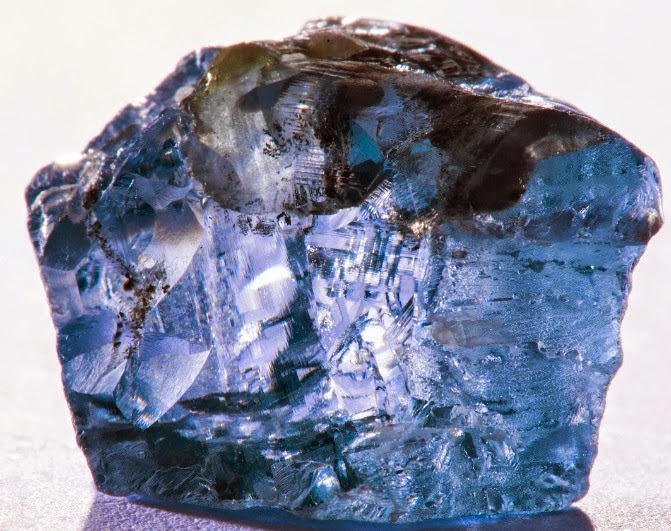
The Blue Moon Diamond’s geological rarity and significance stem from a combination of factors that make it a truly exceptional gemstone. From a geological perspective, the Blue Moon Diamond stands out due to its extraordinary color, exceptional clarity, and the specific conditions under which it was formed. Let’s explore these aspects and compare the Blue Moon Diamond with other famous diamonds or colored diamonds in terms of their geological uniqueness.
- Color and Boron Presence: The Blue Moon Diamond’s vivid blue color is a result of the presence of boron impurities within its crystal lattice. While boron is responsible for other blue diamonds as well, the distinct hue and intensity of the Blue Moon Diamond’s blue color contribute to its rarity. The specific arrangement of boron atoms and the conditions required for such a striking blue color are exceptionally uncommon, making blue diamonds like the Blue Moon Diamond truly geological anomalies.
- Exceptional Clarity: The Blue Moon Diamond’s internal flawlessness (internally flawless grade) adds to its geological rarity. The absence of visible inclusions under magnification indicates a pristine formation process and minimizes any disruptions to its crystal lattice. Diamonds with such impeccable clarity are exceedingly rare in nature, highlighting the exceptional circumstances that led to the creation of the Blue Moon Diamond.
- Size and Carat Weight: While not the largest diamond ever discovered, the Blue Moon Diamond’s size and carat weight, especially after its cutting and polishing, contribute to its geological rarity. Larger diamonds with exceptional color, clarity, and overall quality are far less common, making the Blue Moon Diamond a remarkable find from a geological standpoint.
Comparison with Other Famous Diamonds: When comparing the geological uniqueness of the Blue Moon Diamond with other famous diamonds or colored diamonds, we can consider diamonds like the Hope Diamond and the Pink Star Diamond:
- Hope Diamond: The Hope Diamond, known for its deep blue color, is famous for its historical significance and legendary curse. While both the Hope Diamond and the Blue Moon Diamond are blue, the Hope Diamond’s color is attributed to trace boron impurities as well, though the specific geological and chemical conditions that led to its color are distinct. The Hope Diamond’s rich history and size (45.52 carats) contribute to its geological significance.
- Pink Star Diamond: The Pink Star Diamond, formerly known as the Steinmetz Pink, is one of the world’s largest and finest pink diamonds. Its exceptional color, combined with its large size (59.60 carats), contributes to its geological rarity. Pink diamonds are also extremely rare, and the Pink Star Diamond’s unique attributes make it a geological marvel.
In summary, the Blue Moon Diamond’s geological rarity and significance lie in its combination of factors: its vivid blue color attributed to boron, its exceptional clarity, its size, and the specific geological processes that led to its formation. While other famous diamonds share certain geological characteristics, each gem stands out due to its distinct combination of attributes, making the Blue Moon Diamond a remarkable and highly treasured geological wonder in the world of colored diamonds.
Distribution and Mining Locations
The distribution of diamonds, including rare and valuable ones like the Blue Moon Diamond, is influenced by specific geological conditions and regions that are conducive to their formation. While diamonds can be found on almost every continent, the majority of diamond production comes from a few key mining locations around the world. Let’s explore some of these important diamond mining regions:
- Africa:
- Botswana: Botswana is one of the world’s leading diamond producers, with significant deposits found in areas like the Orapa and Jwaneng Mines. The country is known for producing high-quality diamonds, and the Letlhakane Mine is one of the sources of fancy colored diamonds, including blues and pinks.
- South Africa: South Africa has a rich history of diamond mining and is famous for its diamond deposits in the Kimberley region. The Cullinan Mine, where the Blue Moon Diamond was discovered, is also located in South Africa.
- Russia:
- Russia is a major diamond-producing country, with mines such as the Mir Mine and the Udachnaya Mine. Russia’s diamond production includes both industrial-grade and gem-quality diamonds.
- Canada:
- Canada is known for its high-quality diamonds, particularly from mines like the Ekati Mine and the Diavik Mine in the Northwest Territories. The country is known for producing large, transparent, and high-clarity diamonds.
- Australia:
- The Argyle Diamond Mine in Australia, particularly known for its pink diamonds, has been a significant source of colored diamonds. However, the Argyle Mine ceased operations in 2020, which has contributed to the rarity of pink diamonds.
- Other Regions:
- Diamonds have also been mined in various other regions, including Brazil, India, and some parts of Asia. These regions have contributed to global diamond production, albeit to a lesser extent.
It’s important to note that the geological processes that lead to diamond formation are complex and require specific conditions, such as the presence of diamond-bearing kimberlite and lamproite pipes. As a result, diamond mining is concentrated in regions where these geological conditions are present.
While the Blue Moon Diamond specifically originated from the Cullinan Mine in South Africa, its rarity and value are enhanced by its exceptional color and clarity, which are unique even among other notable diamonds from different mining locations. Each diamond-producing region has its own geological characteristics, and the discovery of remarkable diamonds like the Blue Moon Diamond highlights the diversity and wonder of Earth’s geological processes.




































